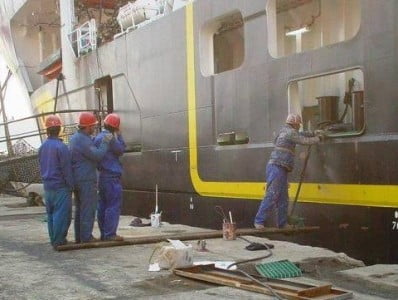The Gemba Beyond the Window
I love the smell of machine oil. I love to hear the clanging and clanking of machinery in operation. I love the banging when one machine hammers away at a piece of metal to form it into something new or the high-pitched “whir” of a loom or spinner in operation. And I love the way huge apparatus groan and creak, as if they are alive and straining under the pressure of the heavy load they are bearing.
I especially enjoy watching the people hard at work creating things that other people will use. To watch an inspector strain under a magnifying glass or microscope to make sure the product is to specifications; or the whizzing around of the forklifts and the occasional and unique “beep-beep” to let them know they are coming through; or the machine operators as they watch the mechanical monsters that are their charge toil away; precisely, steadily, relentlessly.
Indeed, there is nothing like walking around a shop floor and just observing man and machine.
A person can tell a lot about a business’ operations, culture and its health just from walking around the shop floor. When I walk a shop floor (or warehouse) I can almost precisely predict which companies are destined for success and which ones are bleeding cash or on the “morphine drip” – on the path to their demise. In Lean, we call walking the shop floor by a person in management, a “Gemba” walk; or walking “the real place”.
Think about the shop floors you might have walked in the past – or the one you might walk tomorrow…
There is usually a single entrance to the shop floor that is closest to the General Manager’s office. In almost every company, the best looking part is where the manager can immediately visit – I will call it “the foyer”. This area of the shop floor, closest to this particular door, is in the finest shape as compared to any other place in the building. It has: the best lighting, the shiniest floors, the newest machines, the boxes have no creases or dents, and the tools and inventory are (mostly) put away. It will certainly make the best impression available to anyone who might look inside – much like the foyer to a home. This is precisely what the General Manager wants to see when he looks out the little window in the door – and it is this view that he projects as existing throughout the rest of the facility. The workers on the shop floor are eager to support and perpetuate this myth because it means the General Manager will stay in his office and not have cause to inspect the rest of the facility; especially – God forbid – the warehouse. The illusion is complete.
However, looking through the window is not Gemba. No Sir; to see Gemba means you have to be prepared to get dirty and you have to be prepared to see what you don’t want to see – the waste and corruption.
I once went to a manufacturer of computer cabinets and racks – the kind that you see in pictures of server farms. The owner was very proud of his facility and, on the surface it might have looked like there was a proper degree of order. But when I looked on the floor, I saw parts lying about – and parts is inventory. I also saw hand tools such as screw-drivers and drill-bits on the floor. When I questioned the owner, he didn’t seem to think it was a big deal. I began to take a tally of the inventory and tools I saw laying around and, later, asked the inventory person to give me the costs of the items.
Much to the surprise of the owner (but not to me), the value of this casual and certainly incomplete assessment of inventory and tools that were cast about the place was in excess of $5,000. Even worse, an inquiry into the janitorial team resulted in the discovery that they routinely sweep-up and throw-away this inventory each and every week (fortunately, they recognized that tools have value and should be saved). Quite probably, the annual value of the loss just from discarded inventory alone was in excess of $250,000 (probably closer to $400,000 if a full assessment had been done). If you add to that; lost productivity as a result of looking for misplaced inventory and tools, redundant purchases, expediting fees, etc… the annual loss could reasonably approach $1,000,000.
After this awakening, the business owner made the statement; “How can we get the people on the shop floor to understand this? They never even look down!” I disagreed with him and responded, “They look down, they just don’t appreciate what they see – just like you didn’t.”
To demonstrate; the next morning, before anyone else came to work, we walked the shop floor together and placed money in a dozen disparate locations around the facility – always within three feet (3’/1m) of an inventory item or tool that was strewn on the floor. And we did not place a large amount of money, just amounts ranging from a quarter ($0.25) to a dollar.
By 10am, all of the money was gone – but the inventory and tools were still there.
The owner asked my advice as to how he might get his people to see that this is waste, that the practices are wasteful, and that the behavior needed to change. I told him:
1) First; YOU have to realize that everything is money. Not just that it costs money, but that it is actually hard cash money. You have to believe that a hinge lying on the floor is cash. When a box of material is moved, you have to believe it’s a till full of cash. When you throw product away, you are throwing away cash. And when your product is stored on the shelf, it’s the same as putting cash under your mattress – not working for you at all and hardly safe.
2) Second; YOU have to live this. You have to be ever-vigilant in seeing where the cash can become lost and where it leaves. You have to get out of your office every day and walk the floor, look around, talk with the workers – and listen to them. And you have to be pro-active in stopping the hemorrhaging, wherever it might occur (even in your own office). Lead by example.
3) Third; YOU have to instill this new way of life as part of your corporate culture. You have to communicate it effectively; tell of the new way and the reason behind it. People will accept it when they understand that there are benefits – if not directly to them, at least to the business for which they work. This, in turn, will increase the likelihood of the business existing in the future – and along with it, their jobs.
There is a saying that goes, “cleanliness is next to Godliness”. I don’t know about that, but I do know that “cleanliness is next to profitability”.
Waste and inefficiencies are not all you can find on a simple journey to Gemba. You can also spot safety hazards (both situational and behavioural) that have gone unchecked – and it’s only dumb luck that you have not already suffered a loss because of it. For instance;
- Are there any combustibles near a flame or heat source?

- Are there any hazardous materials unnecessarily exposed?
- How about the stacking of product, is it about to topple over?
- Those wires over there – they seem to be chaffed to the point of being exposed. Are you looking to fry someone?
- That guy on the catwalk! He doesn’t have a safety harness! Is he someone you want to keep around? If he falls, what are the chances we can hide the body so nobody will know?

- The horn not working on the forklift – no worries, I am sure everyone can hear the driver yell “beep, beep”.
- Just ignore the leaking roof creating a puddle on the floor. I am sure nobody will slip and fall into the high-voltage transformer or into the vat of nasty flesh-eating liquid.
- Welcome to “Dr. Evils Lair”…
Given the chance, people will do some incredibly stupid things all in the name of getting their job done.
I visited the offices of Royal Dutch Shell in Aberdeen, Scotland a couple of years ago. I have never been to a place of business where there was such an emphasis on safety – not before and not since. The very first thing upon our arrival, our host instructed us on the safety procedures; where the fire exits were, where to rally in case of an emergency (this was updated throughout the day as we moved around the facility) – and especially to “hold the rail”.
One of the most important safety rules at Royal Dutch Shell and one that everyone must follow, is to always hold the rail. Whether going upstairs, downstairs, or just standing on the stairs – if there was a rail, you better be holding it. If you were not holding the rail, you will be told about it; and you will be told about it by anyone who might see you not holding the rail (regardless of “rank” and whether they are with your party or not). When I queried as to why such an emphasis, our host responded that; “It is one of the most important acts of accident prevention an individual may perform on a drilling rig in the North Sea or in other hazardous environments – and it needs to be practiced continually and without exception, so that it becomes a native behaviour.” It reminded me of the first lesson I was taught when I first learned to sail, “One hand for the boat and one hand for yourself.”
Yes, the opportunities for improvement abound and are all around us – but you won’t see them sitting at your desk like some entitled Apparatchik looking at a spreadsheet or talking on the phone with “corporate”. You have to get up off your chair, get out of the office, be ready to get dirty and walk Gemba. Most importantly, you have to keep your eyes and ears open. Don’t just do an “eyes-front” continuous movement stroll as you walk Gemba – make sure to stop, look and listen. Watch with great intent the goings-on in Gemba and listen to the people who are working there – not just as they speak to you, but as they speak to one another.
And when you think you are in touch with Gemba on the shop floor, you are ready to face your greatest challenge – what’s going on in the deepest darkest recesses of the company, where all of the largest corporate sins really lurk… the WAREHOUSE!
 Paris is the Founder and Chairman of the XONITEK Group of Companies; an international management consultancy firm specializing in all disciplines related to Operational Excellence, the continuous and deliberate improvement of company performance AND the circumstances of those who work there – to pursue “Operational Excellence by Design” and not by coincidence.
Paris is the Founder and Chairman of the XONITEK Group of Companies; an international management consultancy firm specializing in all disciplines related to Operational Excellence, the continuous and deliberate improvement of company performance AND the circumstances of those who work there – to pursue “Operational Excellence by Design” and not by coincidence.
He is also the Founder of the Operational Excellence Society, with hundreds of members and several Chapters located around the world, as well as the Owner of the Operational Excellence Group on Linked-In, with over 25,000 members.
For more information on Paris, please check his Linked-In Profile at: http://de.linkedin.com/in/josephparis
37752

